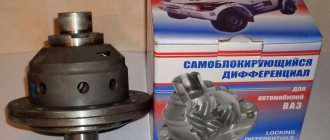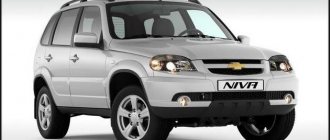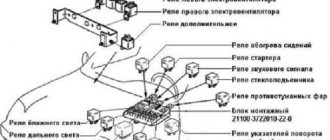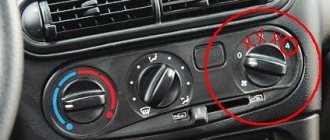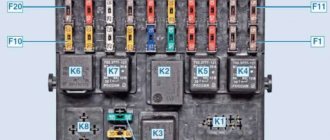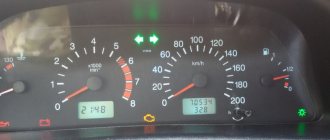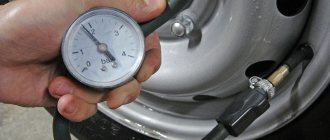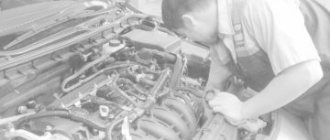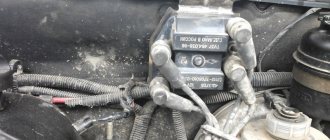We continue scientifically educational topics on the operation of a Chevrolet Niva car. In the last topic we learned how to properly use rubber ink, in this topic we will look at the most important secret of the Chevrolet Niva, How to turn on the RK correctly. The first secret is to listen less to Nivavadov, yes yes Nivavadov, because there is no other way to characterize such people, it’s interesting even if a person, as he often claims, has been driving in the fields for 20 years and talks about strange manipulations with the steering wheel and other things when turning on the center differential, forward, backward, etc. Honestly? a song by a 13 year old boy who found a strange videotape and his parents were not at home. Let's figure out how to do the right thing: Open a wonderful little book like this -
find page 36
Where it is written and even drawn (Blocking and unlocking the center differential in the transfer case is carried out by switching lever 1 to the appropriate position, see the section “Moving the vehicle” (page 49).) we go further.
There are also a lot of books, but if you read everything carefully, you will find the answer, if of course you don’t read it, then you can go to topics like this, where I’ll tell you about the boy and the videotape. And now I’ll explain to those who didn’t understand: Switching the RK diff is carried out on the go! and when pressing the clutch. The so-called torque decay!, due to this, rapid switching on and off occurs. And yes, this Lever does not connect the Front Axle of the Christmas tree, Niva PP. Of course, as without Video in our time, dedicated to all lazy Video lovers.
Guys, honestly, listen less to Nivavadav, otherwise then fairy tales appear about stopping with the steering wheel here, with the steering wheel here, back and forth. Suddenly, then it turns out that the Diff rk on the Shnivy doesn’t turn on well, of course, why shouldn’t it turn on badly if they try to turn it on in one place. Feel free to use the manual; it was written for these purposes. To the question, why are you going crazy? yes I'm going crazy)
Recently, SUVs and crossovers with all-wheel drive have become very popular. If previously preference was given only to cars with high ground clearance, now the presence of a 4x4 transmission is a priority.
But such technology can be implemented in completely different ways; let’s look at the structural features of the center lock and clutch on a Chevrolet Niva car.
Drive device.
The classic Niva 2121 became the first Russian SUV to be equipped with an all-wheel drive transmission. Among the main features of this transmission was the ability to lock the center differential. Many people mistakenly believe that this unit is necessary to connect the front axle. But in reality, the front axle is always in the connected position. Let's try to understand the design of the car in more detail.
The chassis of the car is designed in such a way that torque from the engine is transmitted through the gearbox to all 4 wheels at once. This operating scheme allows you to show the best performance when moving off-road, while at the same time significantly reducing the cost of the main parts.
Main transmission components:
- Gear box,
- Razdatka,
- Drives and cardan shafts,
- Front and rear gearboxes.
It is the transfer case in the car that is responsible for distributing torque between the axles. On the Chevrolet Niva it is two-speed and its presence provides the following advantages:
- Smooth vehicle movement at low speeds at high engine speeds.
- Distribution of forces between the axles of the car depending on specific road conditions.
The differential is necessary to distribute traction forces. In practice, this allows two wheels to rotate on the same axis at different speeds. The Chevrolet Niva has 3 differentials, which allows each wheel to have its own angular velocity.
Cardan shafts are necessary to connect transfer cases and axle gearboxes. Chevrolet Niva shafts have one interesting feature: they have exactly the same design, as a result of which they are interchangeable and if one of them fails, if necessary, you can sacrifice all-wheel drive, but get to the nearest service station yourself.
Rules for using differential
These include:
- Switching the transfer case should only be done when the car is not moving.
- You can also engage the differential while the vehicle is moving.
- You can switch to a lower gear while the car is moving.
- To ensure long-term and uninterrupted operation of the differential, it is necessary to periodically turn it on, especially in winter. This should be done once every 7 days.
Shift lever location
In the interior of the Niva Chevrolet, there are two levers between the front seats . Using one of them you can change gears in the gearbox, and using the other you can control the transfer case.
Differential shift lever
The transfer case is based on a gearbox consisting of two stages . The control lever comes out of it into the cabin. He can move forward or backward. At the same time, it switches on/off downshift. If the lever is moved left or right, it can turn the differential lock on/off.
Gear shift and transfer case diagram
Downshift: what does it give?
The main component of the transfer case is the reduction gearbox . If the control lever is in the rear position, then the number of transfer cases decreases and is 1.2 . When the lever is in the forward position, the gear ratio increases. It will already be 2.1 . When the lever is in the neutral position, the gear ratio is equal to .
The differential is an integral part of the all-wheel drive mechanism in any car. It is recommended to use it only when the car is moving off-road.
Operating principle of the drive.
By default, the SUV uses high gear with the center differential disabled. The engine transmits force to the gearbox, which is fed through the shaft to the transfer case gearbox. The transfer case contains a center differential, which connects the front and rear axles.
How does all-wheel drive work on a Chevrolet Niva if the differential is locked.
If you turn on all-wheel drive on the Niva, the cardan shafts will be blocked using a special clutch. In this case, there will be an even distribution of torque between the axles. The vehicle's cross-country ability will increase significantly, but at the same time, handling will become slightly worse.
Modified versions
The Niva's standard transmission, for all its advantages, often causes uncomfortable noise in the cabin. This is generally related to the design, but using engineering developments, you can modernize it and make the car much quieter.
This approach has already been applied in VAZ-21213 cars; as a result, even at a speed of 100 km/h you don’t feel any unpleasant noise, you can talk calmly and hear your interlocutor without effort. For these purposes, a number of modernization methods have been used: from unloading the floor near the transfer case and manual transmission mounts, reducing the load on shaft bearings to smoothing out peak torques under conditions of increasing loads on the transmission.
Also interesting: How to remove the window regulator on a Niva Chevrolet
The noise in the modernized Niva transmission is comparable to that of a Zhiguli. It becomes more comfortable to be in the car when driving off-road. Upgrade costs are negligible; modification requires only the master's understanding of the design itself and a little time.
Turning on all-wheel drive.
The use of blocking will be justified in the following cases:
- If there is a possibility of wheel slipping, in areas with poor surface conditions,
- If there is a lack of engine thrust at high speeds,
- When driving on roads with loose surfaces, snow, ice.
You should also take into account some features of the Chevrolet Niva, namely, the helplessness of the transmission when hanging diagonally. In this mode, the wheels begin to spin, so if necessary, you need to dig under the wheel or make an embankment under the raised axle.
Many car enthusiasts like SUVs due to their high maneuverability in difficult terrain. Among domestic cars, a striking example is the Chevrolet Niva brand. And in order for the car to be able to overcome hard-to-reach obstacles, you cannot do without differential locking on the Niva. Regardless of the brand of SUV, including the aforementioned Niva, all cars have one characteristic feature, which is the presence of all-wheel drive and differential. More detailed information is provided below.
Disk lock
There are many options for implementing such a lock, but they all have a common principle - the differential here is equipped with two sets of discs. As soon as slipping occurs, the clutches compress and equalize the angular velocities. The discs are similar to automatic transmission clutches. They do not interfere in any way with the civilian operation of the car. The preload here is created by a spring or conical rings.
The SV-PARTS store offers locking for everyday driving on the Niva for axle shafts with 22 or 24 splines:
This makes it possible to use this product even on the good old Niva, produced by AVTOVAZ, or on its “younger” sister – Chevrolet Niva:
For convenience, you can purchase a rear axle gearbox assembled with any lock, like this self-block with a 4.1 main pair:
Those who like to push themselves will be more pleased with SV-PARTS. It looks like a normal differential. Housing, two covers, 10 satellites inside (5 for each wheel). Plus a gear that blocks one drive relative to the other, and preload washers.
The product “stands up” without any modifications. Can be used on cars of the classic VAZ family. The design is distinguished by washers placed outside and a modified inclination of the teeth. Careful adjustment of the elements ensures a service life of 120 thousand kilometers. The car will be able to compete in drifting, rallycross, or, in the case of the Niva, in competitions such as Off Road.
Definition of the term
What is a differential? Its mechanism includes a group of planetary-type gears. Its main purpose is to transmit torque from the engine to the drive wheels of one axle. In this case, the wheels rotate relative to each other at different speeds.
Cars that have only a pair of driving wheels have a planetary mechanism placed between their drives, which is otherwise called a cross-axle differential. However, most SUVs have all-wheel drive, and in this case it is located between the axles - this is the center differential. The traction force of a wheel depends on its radius and the supplied torque.
Before installing a differential lock on the Niva, it is worth understanding its mechanism. As a rule, many SUVs have only one differential installed - inside the drive axle. There are three of them on the Chevrolet Niva car. In this case, each of the two is located in the rear and front axles, respectively. They allow all wheels to rotate relative to one axis at different angular speeds. The third mechanism, as described just above, is located between the axles and distributes the torque from the engine between the two axles.
How do you turn the lock on and off?
The lever has several positions
: (connection diagram)
- central location of the lever - “neutral” is turned on, even when the gearbox is turned on, the car will not be able to drive, because the connection to the wheels is disconnected;
- moving the lever forward - the lowering switch is activated;
- switching in the opposite direction - correspondingly turning off the downshift;
- the transfer case lever is moved to the left - the center differential lock is ON;
- the lever is moved to the right - the lock is OFF.
Explanation of the designation:
- (I-Н) – differential is unlocked, reduction is turned off. This is a mode for everyday driving.
- (III-L) – the differential is disabled, low gear is in operation.
- (IV) – reduction is disabled, the differential is locked. In this case, all wheels of the vehicle rotate at the same speed.
- (VI) – the differential is locked, the reduction gear is in the on state.
To engage the differential lock on the Niva, you must press the clutch and move the transfer case lever to the left. To disable the lock, move to the right side (away from you).
Why the lock may not turn off
A common problem with the center differential on the VAZ-2123 is the locking lever souring.
Since the adjustment unit is located under the bottom of the car, it is susceptible to corrosion and sand deposits in moving joints.
It is necessary to clean the assembly from dirt and rinse it several times with WD-40. After this, you can try to disengage the jammed lock by forcefully switching the lever when you start moving the car in reverse or forward.
Advice! To avoid frequent jamming of the differential lock, it is recommended to periodically turn it on once every 6-8 days.
Why might the blocking not turn on?
The main cause of the problem is that the locking clutch in the transfer case does not engage the corresponding ring gear (the grooves and teeth do not match). In this case, it is advisable to try to engage the lock by gently and continuously pressing the transfer case lever while the car is moving.
In this case, it is necessary to constantly slightly steer the car in different directions (rocking the steering wheel) to create conditions for the differential to operate and the ring gear to coincide (engage). Similar articles:
All about the all-wheel drive of the Chevy Niva - permanent or plug-in?
Niva Chevrolet transfer case control: device, how to turn it on and off?
How to repair a Chevrolet Niva transfer case with your own hands: detailed disassembly instructions
Types of differentials
Depending on the type of gears used, the differential can be:
The cylindrical mechanism is mainly installed on cars with all-wheel drive. This is where the differential lock on the Niva would come in handy.
A bevel differential, usually symmetrical, is placed between the wheel drives.
Worm torque transmission is quieter than its analogues, but has a more complex design. It is a universal option, since it can simultaneously be an inter-wheel and inter-axle differential.
Also, the differential can be symmetrical or asymmetrical, depending on the number of teeth.
Differential operating principle
On the one hand, the differential provides the driver with comfort and safety when driving a car on a hard and dry road surface. On the other hand, everything is not so simple - as soon as you go beyond its limits or get on a slippery surface, the differential makes it impossible for the car to move.
Depending on the situation, the planetary mechanism operates in one of three modes (sometimes differential locking on the Niva is not needed):
- When the car is moving in a straight line.
- When entering turns.
- The car drives through a slippery surface.
Electric drive
We offer an affordable and effective option - the UltraBLOCK system. The mechanism is protected from moisture and dust. It is activated by pressing one button and within 10 seconds it turns on the lock. The differential itself will not unlock, even when the power is turned off - it can only be released by pressing the button again.
Read news about the new Niva
- Niva Travel flashlights - why are they better? |
- Front bracket with platform for Lada4x4 winch, NP-00156, price 5870 rubles. Buy
- Bracket for a winch in a standard Chevrolet NIVA bumper (hidden installation!)
- Installation of the niva 777 winch bracket on a Chevrolet Niva (VAZ 2123) | body and external tuning of Chevrolet Niva (VAZ 2123)
- All-terrain vehicle fracture 4x4: photo of step-by-step assembly video of a trip on an all-terrain vehicle
- 4WD Features and Comparison
- Kenguryatnik on Chevrolet Niva: selection criteria, material, installation
- Kenguryatnik on Niva, selection and installation of accessories
Features of cornering
Here it’s worth mentally (preferably on paper) to draw a schematic picture of how the car turns. This promotes better perception. Just when cornering, the differential starts to come into play. And here the differential lock on the Niva can only do harm. The whole peculiarity is that the wheel, which is closer to the center of the turn (inner), moves along a small radius and covers a shorter distance. And the wheel that is located further from the center of rotation (outer), accordingly moves along a large radius and covers a greater distance.
At the same time, increased resistance acts on the inner wheels of the car, which forces them to reduce their speed. On the contrary, the outer wheels need to move faster, due to the same larger radius. And if there were no differential, each turn would lead to increased wear on the tires of the wheels. And if the speed of the car is high, then a skid cannot be avoided. You should know this before installing a differential lock mechanism on the Chevrolet Niva.
This suggests that the wheels must rotate at different angular speeds. When the car begins to turn, the satellites rotate around their axes, which leads to a slowdown in the speed of the axle shaft of the inner wheel, while the angular speed of the axle shaft of the outer wheel, on the contrary, increases.
This is how the vehicle turns smoothly. Despite the difference in angular speeds, the traction force of all wheels is the same, since the main torque does not change. Of course, this is provided that all wheels have the same grip.
Differential lock on Niva (self-block): bringing the car to perfection
Content
- What are we dealing with?
- Coefficient, preload and other nuances
- Types of blocking on Niva
- Limited slip self-block (LSD)
- Forced blocking
- How to decide what to install?
What are we dealing with?
What is a differential or as it is sometimes abbreviated as “diff”.
Why is it needed?! The Latin word “differentia” and the similar English word “different” are translated into Russian almost identically: “difference” or “different”. There is another definition of differential - planetary gear. The purpose of this element is to transmit the power of the power unit through rotation without losing it on the axle shaft with the wheels attached to them. The differential causes them to rotate at different speeds depending on driving conditions. Inside a turn, the wheel makes much fewer revolutions than one that goes along a long radius. If in place of the “planetary” there was an ordinary solid axle, the probable parasitic circulation of power would guarantee a decrease in control over the car, loss of traction with asphalt, significant wear of the transmission, incredible fuel consumption, etc. The differential “links” the drive of one axle, removes the “parasitic” phenomenon, without loss of power.
An interwheel differential is present in almost all cars. It is usually located on the drive axle. There may be two or more axes to which the planetary gear distributes the incoming power flow.
Back to Contents
Coefficient, preload and other nuances
The Niva 2121 is equipped with permanent all-wheel drive, and therefore, in addition to two inter-wheel differentials, it has a third - an inter-axle differential, distributing the moment between the front and rear.
A regular “free” differential is not always enough for a Niva owner. An SUV is bought to drive like a mother-in-law on different terrain and surfaces: dirt, snow, ice, etc. Often a car ends up with two wheels on a grippy surface and the other side on a slippery texture. In such a situation it is easy to “lose” him. Blocking will allow you not to worry about this.
When choosing a block, you need to take into account two important points - blocking coefficient and preload. The first denotes the ratio of torque on the lagging wheel with good grip and on the leading wheel, which has already lost contact with the road. A free differential has a coefficient of 1. For self-locking ones, it is up to five. That is, the lagging wheel will receive 5 times more torque. This parameter is sometimes indicated in %. For worm gears it is determined by the inclination of the teeth, for disk drives it is determined by the configuration of the friction clutches.
And preload is a certain moment of blocking inside the body of the product even before the moment when it may be required. Mostly in modern self-blocks, preload is created by washers. It can be customized to suit almost any driver's requirements. The washers can be replaced as they wear out, and the differential will continue to serve faithfully for many more years. While the teeth of the “worm” and the clutches of the “disc” design wear out sooner or later, the preload decreases.
True, it is important not to “overdo it” here - excessive preload greatly increases the load on the differential itself and increases the wear of all transmission elements.
Back to Contents
Types of blocking on Niva
“Native” differentials can be replaced with a self-locking analogue of increased friction or with a device where the “planetary gear” is locked forcibly. For those who want to install a self-block on a Niva themselves, we will try to thoroughly explain the difference between a worm, screw or disk lock. Let’s evaluate each design that works “from the button.”
Limited slip self-block (LSD)
A limited slip differential or limited slip differential is installed on various sports cars. Many companies have been mass-producing such things in Russia for a long time and in large quantities. It initially has limited slip. This thing independently equalizes angular velocities. It essentially serves as a direct transmission, as if the power is transferred to a single “stick” on which two wheels rotate equally. Can also be installed on a Niva 2124 car.
LSDs are distinguished by the response format - from the occurrence of a difference in angular speeds (disc) or when the torque changes (screw).
Disk lock
There are many options for implementing such a lock, but they all have a common principle - the differential here is equipped with two sets of discs. As soon as slipping occurs, the clutches compress and equalize the angular velocities. The discs are similar to automatic transmission clutches. They do not interfere in any way with the civilian operation of the car. The preload here is created by a spring or conical rings.
The SV-PARTS store offers locking for everyday driving on the Niva for axle shafts with 22 or 24 splines:
This makes it possible to use this product even on the good old Niva, produced by AVTOVAZ, or on its “younger” sister – Chevrolet Niva:
Self-locking disc differential VAZ 2123 (24 splines)
Art. SDS.23
13000.00
— +
Buy
For convenience, you can purchase a rear axle gearbox assembled with any lock, like this self-block with a 4.1 main pair:
Rear axle gearbox: main pair 4.1 (2103) + screw lock (22 sh.) SV-PARTS
Art. SV.03.00031752
13500.00
— +
Buy
Those who like to push themselves will be more pleased with SV-PARTS. It looks like a normal differential. Housing, two covers, 10 satellites inside (5 for each wheel). Plus a gear that blocks one drive relative to the other, and preload washers.
Self-locking differential 2101, 2107, 2121 screw 3-piece (22 splines) SV-PARTS
Art. SV.01.2403018
7500.00
— +
Buy
The product “stands up” without any modifications. Can be used on cars of the classic VAZ family. The design is distinguished by washers placed outside and a modified inclination of the teeth. Careful adjustment of the elements ensures a service life of 120 thousand kilometers. The car will be able to compete in drifting, rallycross, or, in the case of the Niva, in competitions such as Off Road.
Worm self-block
The worm gear design is named after its main principle - sensitivity to torque. In English it is "torque sensitive", which defines the term Torsen. These self-blocks have been widely known since the last century. In them, the satellites are replaced by a “worm” - an irreversible transmission that transmits torque exclusively from the “worm” to the semi-axial gear.
There's no way the worm can turn the wheel here. In normal modes, the design easily works like an ordinary free differential, but as soon as one of the wheels hints at slipping, the locking is instantly activated and does not physically allow even the slightest idle rotation of the second wheel.
Screw block
Worm and screw locks are often confused, since the screw lock is the same Torsen product, but in a more modern design. It is simpler in many ways and quite popular. Essentially, this is a worm gear with a longitudinal arrangement. Its design feature ensures the occurrence of several friction pairs at once. The worms expand in such a way that they close both lengthwise and crosswise.
This unpretentious lock for the Niva 2121 easily replaces the standard planetary gear. It blocks the wheels by 70%, but that's enough. Preload is created by springs inside the housing. As they wear out, the lock does not lose its properties - it is simply connected a little later. It is important to take into account only one thing - it is practically useless when hung diagonally.
Self-locking differential VAZ 2101-2107, 2121 screw Avtosprinter
Art. 21010-2303010-00
7500.00
— +
Buy
An example of such a thing is a blocking produced by VAL-Racing in the rear axle or front gearbox of a Niva 21213 produced before 2002, as well as in the rear axle of a Niva Chevrolet:
Self-locking screw differential VAZ 2101-2107, 21213 VAL-racing
Art. 21010-2403018-00
11100.00
— +
Buy
In the SV-PARTS store, of course, differential locking for the Chevrolet Niva is also available:
Hit
Self-locking differential 21214, 2123 screw 3-piece (24 splines) SV-PARTS
Art. SV.23.2303018
7500.00
— +
Buy
Back to Contents
Forced blocking
Such products block the differential 100% and, as the name implies, they are operated by the driver. They are distinguished from self-blocks, for example, on the Niva 21213 car, by the presence of a clutch, which is mounted in the standard differential housing. With such a thing, by the way, the “diagonal” is not scary, you just need to choose the appropriate option.
Pneumatic locking
Structurally, this is a regular free differential. It is modified by installing a pneumatic drive. Easy to install. You just need a tuned gearbox with a differential, a pneumatic release (valves and lines), a compressor with a receiver. Of course, the price is higher, but it certainly has its advantages.
For example, a reinforced four-satellite differential with forced pneumatic locking will allow you to compete in competitions. The presence of such a thing in the front and rear axles opens up the possibility of installing huge wheels. This product has been tested for more than ten years and has repeatedly confirmed its reliability. The pneumatic drive here is miniature - the whole thing fits into the gearbox housing, and therefore is reliably protected from damage. The kit includes everything you need for installation - right down to the fitting:
Forced pneumatic differential lock 21214, 2123 Niva (4 satellites, 24 splines)
Art. 21230-2303018-87
33500.00
— +
Buy
Accordingly, there is an option for 22 splines:
Forced pneumatic differential lock 21214, 2123 Niva (4 satellites, 22 splines)
Art. 21010-2403018-87
33500.00
— +
Buy
Its service life is designed for the entire life of the car. In this case, the differential is repairable. To better understand what exactly it is, just watch the video!
There is a two-satellite option, it does not fit on the Chevrolet Niva, but is universal for the Niva 2121 and the entire classic family of VAZ cars. It is best used for relatively quiet trips out of town:
Forced pneumatic differential lock VAZ-2101, 2121. 4 satellite, 22 splines
Art. SV.23.2403018.12
33500.00
— +
Buy
Yes, SV-PARTS has two options for a ready-made pneumatic system! Both are equipped with excellent Berkut compressors, pneumatic distributors, a hose and a gun, oblique wires, as well as a set of sensors and relays:
Pneumatic system based on R17 Berkut for SUVs
Art. R17
22000.00
— +
Buy
Electric drive
We offer an affordable and effective option - the UltraBLOCK system. The mechanism is protected from moisture and dust. It is activated by pressing one button and within 10 seconds it turns on the lock. The differential itself will not unlock, even when the power is turned off - it can only be released by pressing the button again.
Forced electric differential lock 21214, 2123 Niva
Art. 21213-2302010-196
21000.00
— +
Buy
Welding (Spool)
Finally, we present the cheapest and simplest option - “leaving”. This is a 100% rigid connection of the axes to each other. The main purpose - to ensure a stable stall of the rear wheels - will please those who like to “fall sideways” on everything. It may also be useful for those who are studying the question of which self-block is better for Niva 21214:
Pseudo Differential VAZ 2101-2107, 2121 Spull welding
Art. 21010-2403018-10
4500.00
— +
Buy
Please note that for Niva 21214 - Niva 2123 cars there is another option. Perhaps it will help you decide and install a self-blocking system on a Chevrolet Niva:
Pseudo Differential VAZ 21214-2123 Spull welding
Art. 21230-2403018
4500.00
— +
Buy
Back to Contents
How to decide what to install
A self-locking differential on the Niva or turning on the lock from a button in the cabin is an open question. Each car owner is guided, first of all, by his wallet and needs. You can safely go picking mushrooms or fishing if you equip your car with a product such as a rear axle lock on the Niva.
When a car often drives through deep ambushes in muddy roads or heavy snowfall, it is worth taking a more thorough approach to improving its characteristics. We definitely put the block at the rear, and add a screw differential to the front. In this case, the front lock on the Niva will serve as a guarantee of peace of mind and reliability - it won’t leave the fierce swamp, not a tractor, but you won’t have to worry about needing a shovel.
In order not to exhaust Niva in case of the most severe tests, it is better to install a forced lock. Or, as an option, equip the rear with a self-block, and the front, for example, with a product with a pneumatic drive.
In general, for those who periodically experience diagonal suspension on their Niva, we recommend installing a self-locking differential in both axles or, as an option, supplementing one self-locking differential with a second one with forced engagement.
In any case, we do not recommend purchasing a handheld lock with “low mileage” or “almost in use.” It’s always better to pay a little more for a new unit with a manufacturer’s warranty than to blame yourself later for insignificant savings. Moreover, now you know where to look for the best self-blocks for Niva.
Back to Contents
Return to list of articles
Car movement on different surfaces
In this case, a significant drawback of the differential begins to appear, due to its special design. This is where differential locking on a Chevrolet Niva is simply necessary, and here’s why. When a vehicle is driven on a road with slippery conditions or off-road, the wheels are subject to varying degrees of stress. For example, one of them hits a slippery surface, as a result of which it loses traction and begins to slip. The remaining wheels, which maintain good grip on the road surface, experience increased load, which leads to their slowdown.
Here the principle is repeated as when entering a turn. However, in this case it does more harm than good. A wheel with low traction may receive all the torque from the differential, while loaded wheels will stop rotating altogether. As a result, the vehicle's movement stops.
There is a way out of the situation, and it consists of installing a differential lock on the Niva, or you can use the exchange rate stability system. But what does differential lock mean now? Go ahead.
Coefficient, preload and other nuances
The Niva 2121 is equipped with permanent all-wheel drive, and therefore, in addition to two inter-wheel differentials, it has a third - an inter-axle differential, distributing the moment between the front and rear.
Also interesting: Lada 4×4 2121 Niva 1.7 MT Luxury Air Conditioning (10.2016 - 04.2018)
A regular “free” differential is not always enough for a Niva owner. An SUV is bought to drive like a mother-in-law on different terrain and surfaces: dirt, snow, ice, etc. Often a car ends up with two wheels on a grippy surface and the other side on a slippery texture. In such a situation it is easy to “lose” him. Blocking will allow you not to worry about this.
When choosing a block, you need to take into account two important points - blocking coefficient and preload. The first denotes the ratio of torque on the lagging wheel with good grip and on the leading wheel, which has already lost contact with the road. The free differential has a coefficient of 1.
And preload is a certain moment of blocking inside the body of the product even before the moment when it may be required. Mostly in modern self-blocks, preload is created by washers. It can be customized to suit almost any driver's requirements. The washers can be replaced as they wear out, and the differential will continue to serve faithfully for many more years. While the teeth of the “worm” and the clutches of the “disc” design wear out sooner or later, the preload decreases.
True, it is important not to “overdo it” here - excessive preload greatly increases the load on the differential itself and increases the wear of all transmission elements.
What is a differential lock?
As is already clear, when a car hits a slippery surface, one wheel loses traction and takes all the torque, which leads to the car stopping. Many drivers who fall into this trap know very well that the slipping wheel needs to regain traction. To do this, the wheel is loaded or something is placed under it. The wheels of one axle get good traction with the road surface, and the car begins to move.
In this case, it is necessary that the loaded wheels do not lose torque, which is what the differential lock actually serves. The whole point of locking the Niva's cross-axle differential comes down to uniting all the drive wheels and bringing their angular velocity to the same value.
When to use low gear
How to use the transfer case on a Chevrolet Niva is a question that many owners of this car ask. The Chevrolet Niva is a popular Russian SUV not only among extreme driving enthusiasts, but also for those who use the car for personal purposes. Everyone knows that the car is equipped with a transfer case, which is responsible for engaging the lock and downshift.
It is worth noting that all this can be done even simultaneously and this is done using one lever. So, in order to use a lower gear, you need to shift the lever first to the right and then up, but of course, in order to engage in a higher gear, you just need to shift the lever back.
Note that the transfer case can be used to engage neutral gear, which will prevent the car from moving. You can engage the lock both in high gear and in low gear; to do this, you just need to switch the lever to the left.
There is a diagram on the shift lever. To engage a downshift, you need to move the lever to the right, up. To lock the differential, pull it all the way to the left. There are also Latin letters on the lever. So, L is a low gear, N is neutral, and H is high.
Low gear is used in two cases:
- It is necessary to ensure low speed. For example, if you need to drive onto a curb or other obstacle, you can engage a lower gear so as not to burn the clutch.
- Need high torque. A lower gear is engaged before overcoming steep inclines.
The differential lock is activated when driving off-road, where there is a high risk of slipping.
At the same time, it must be turned on before entering a difficult area.
In general, you need to use the transfer case like this:
- Driving on the highway. The differential is unlocked, the first speed of the RK is turned on.
- Overcoming climbs and obstacles on hard surfaces. The differential is unlocked and the reduced speed is engaged.
- Overcoming difficult snowy areas, mud, slippery climbs. Locking and reduced speed enabled.
For what purpose is a transfer case even needed, when does it make sense to engage the locking and downshift? Such seemingly simple, but at the same time serious questions will become clear when considering the following example. When driving on a country road on a hard surface, fourth gear is engaged. Suddenly, a large puddle with a soft, unreliable surface appears in front of the car.
Thus, the low gear of the Chevrolet transfer case is designed for comfortable off-road driving and overcoming various obstacles. In such a gear you need to drive slowly, you cannot accelerate sharply, because at this moment the wheels will receive a large load, as a result of which a real hole can form, from which it will be very difficult for the car to get out.
With this driving style, the motorist will better feel the movement of the wheels, as a result of which, when they “bury”, as evidenced by the chaotic movement of the car, it will be possible to immediately do something after overcoming the obstacle. Most often, this is done by changing the trajectory of the car.
How does blocking work?
In order for the differential to transmit torque from the engine to the wheels and automatically distribute it between them, its design contains gears and shafts. Due to the blocking action, which is carried out by a special locking clutch, the rotation of the gears stops. As a result of the Niva's cross-axle differential locking, the wheels are now firmly connected to each other, due to which their angular velocity is equalized.
The interaxle mechanism has the same principle. Only the front and rear drive shafts are already in close connection. Thanks to this, both axles (front and rear) receive the same torque value. And in this case, a domestic car can overcome serious road obstacles.
Types of blocking
If you want to install a locking mechanism on a differential, you should know that there are two types:
- full blocking;
- partial blocking.
Full blocking mechanisms can operate manually (forced differential locking on the Niva) or automatic mode, while partial blocking is carried out only automatically. Just don’t forget that driving a car with a full lock on a good road leads to premature tire wear. In addition, some parts also fail quickly.
Thus, the whole choice comes down to which mechanism to choose: manual or automatic. The manual system has one advantage - the driver himself decides whether to engage the differential lock or not. However, there are also a number of disadvantages:
- to activate the system, you need to remove your hand from the steering wheel;
- It is imperative to disable the lock in a timely manner, otherwise the chassis of the vehicle may be damaged;
- high price.
The automatic differential lock on the Niva has its own characteristics, among which is the need to customize it to the individual driving style of the car owner. At the same time, the mechanism does not load the car’s transmission as much as its manual counterpart. The system provides complete comfort for the driver, since, if necessary, it is activated without human intervention.
It also all depends on your driving style. For those drivers who prefer a quiet ride on a flat road surface, it is better to opt for a viscous coupling or a disc clutch. In case of extreme driving style, you cannot do without a forced differential locking system on the Niva.
How to buy a lock for a field. the agony of choice.
How to buy a lock on NIVU. Detailed search experience.
Now on the Russian market you can buy a lock at NIVU by choosing from 10 types of designs:
• Disc (viscous couplings) • Cam • Ball • Spools (welded) • Screw • Couplings • Forced pneumatic, hydraulic, mechanical, electronic
For those who don’t want to read the whole article, I’ll tell you: I bought a Doctor Drive screw lock through the manufacturer’s online store, paid by card, sent it the same day, arrived within a week and in normal packaging. I installed it at a service station (I bought new seals, bearings and oil). It helps a lot when off-road. In the city and on the highway it doesn’t feel like it, it turns more confidently. The car has stopped falling into ruts, I drive diagonally, there are absolutely no clicks, rattles or noises at all. In general, I'm happy as an elephant.
There are 20 domestic manufacturers of differential locks:
• STK (Samara Technology Company) • TZS (Togliatti Samoblokov Plant) • AVT (Avtograd Technology) • Tuning technology • IQ Racing Technology • IZH-TECHNO Blokka™ • AVTOSPRINTER • Autoproduct • Doctor Drive • VAL-RACING • DifferBlock • Blocksport • NewDiffer • SV-Parts • NIRFI • LOKKA • INSUV • Octopus • DAK • DAN
There are foreign manufacturers that allow you to buy blocking on NIVU in Russia of their production, but the cost is noticeably higher than domestic ones: • Powertrax GRIP PRO • HF Differential • Yukon gear • Wavetrac • Mfactory • Truetrac® • PELOQUIN'S • Torsen® • Quaife® • EATON • OBX • TJM•ARB
Buying a good quality lock on NIVU is not an easy task, I know it first hand. You can, of course, go to any Off-Road 4x4 store and trust the manager, in this case you will help him fulfill the plan, and not solve your problem of increasing cross-country ability. All you need to do is buy a lock from NIVU at an adequate price, from a normal manufacturer, not a fake, complete, so that it fits evenly, is adjusted, works as advertised, does not make unnecessary sounds, does not break, does not jam, does not lose preload over the season, is with good warranty and spare parts are easy to get. Not a blockage, but a dream! I would like to believe that such a thing exists and that it is possible to buy a lock at NIVU of decent quality.
After scouring the Internet and encountering contradictory statements about blocking, it became unclear what to look for in order to buy a block on NIVU. This is bad. There is no desire to spend your money and time on testing several locks, just as there is no desire to buy outright “hemorrhoids”, I apologize for my French.
I'm not too familiar with blocking to ask. But there are a lot of videos on YouTube, of which it is not clear which is better. The videos do not compare cross-country ability with/without in the same conditions, everything is always different. They can be custom-made from the manufacturer or from some store. Dilemma.
You will have to base your choice on conclusions taken from the Internet in order to buy a lock on NIVU.
After spending a month studying designs, manufacturers, materials, videos, reviews and everything I found, I made certain conclusions about how to buy a lock on NIVU. I want these conclusions to be useful to good people and everyone who wants to buy a lock on NIVU. As a result, in terms of design choice we have:
Forced locking is expensive and there are a lot of “buts” both in terms of reliability, in terms of installation, and in terms of design.
In addition to everything else, pneumatic ones require an expensive compressor, hydraulics confuse manufacturability, mechanical cables can freeze into the braid when the temperature changes, electronic ones require normal installation so that the machine does not burn out. When installing any forced locking, the gearbox must be drilled. Another possible accompanying difficulty is squeezed out oil seals, broken axle shafts, eaten tires if they jam, many elements that can fail at the most inopportune moment, and wasted money and time. I would like to buy a lock on NIVU wisely.
Spools or welds are suitable for extremes - drifting or permanent off-road is ideal. Cheap and cheerful. On my NIVA it will eat up the tires, prevent it from steering normally, and can bend the axle shafts.
I didn’t find viscous couplings in their pure form at NIVU. Maybe I didn’t look well, but it looks like they are part of a series of forced ones to buy a lock on NIVU.
Ball ones are good in every sense, except for the nuances. I found an acquaintance who bought such a lock at NIVU a long time ago, drove more than a hundred thousand kilometers and couldn’t be happier. This is an ideal lock for off-road, permanent and complete. There is one “But” - it is short-lived in everyday life, i.e. in the city and on asphalt it can be “killed” in the first 500 km. It needs to be rolled in mud or snow for a couple of thousand km, then it will last a long time. Not my option, I need to buy a lock on NIVU and immediately use it for its intended purpose.
Cam locks, as I understand it, are intended for severe off-road use, and it’s not so easy to buy a lock of this design on a NIVU - I couldn’t find it on sale. Well, it’s not scary, it’s also not my option, I still don’t understand how it works.
Screw locks turned out to be the most suitable. They run for a long time, are not expensive, are not picky about oil, are easy to disassemble and restore, there is a choice among manufacturers, you can drive around the city as much as you like, they significantly help off-road, of course this is not forced, but I would like to buy such a lock on NIVU. There are a couple of disadvantages - the preload drops after a year or two and you can’t understand which manufacturer makes them properly and with high quality, and who simply charges for the brand or, worse, inflates the price. Let's figure it out to buy a lock on NIVU.
Disc ones are an excellent option, but not for amateurs, but for athletes. But I wanted to buy a NIVU lock with a disc design, I thought more expensive means better. I was wrong. Well started studying this topic in detail.
I spent time searching for manufacturers of screw locks and studied them in detail. As you can see from the beginning of the text, there are as many as 20 of them! I am dumbfounded by this figure, but the fact is the fact. Which one is more profitable to buy a lock on NIVU? Let's take a closer look.
STK (Samara Technology Company). There is little information about them. They mainly make forced locks and not at NIVU. I saw the price 9100 rub. on alsport, and besides, the photo of the screw shows a disk one, maybe they got it mixed up. I don’t want anything to be mixed up when sending it to me. The desire to buy a lock for NIVU from this company was discouraged by a series of photos seen in one of the online stores, I think a piece of hardware with rusty spots will interest few people, I will not attach the photo.
TZS (Togliatti Samoblokov Plant). The guys have been present on the blocking market for more than 7 years. Price on the official website instead of 10,900 rubles. costs 7500r. The discount is suspicious, more than 30%, the felts are being overcharged normally, that they can discount it like that, or they just wrote that the value is higher than the price. Looks decent in the photo. Structurally, it’s exactly the same as STK’s, it’s not clear whether it’s a coincidence or whether they’re made using the same technology, but it’s possible to buy the blocking at NIVU made by them. I found them on a map in the industrial area of Tolyatti, which confirms that this is indeed a “Plant”. I was confused by 2 things: on the main page of their Instagram account there is a blocking from another manufacturer, as well as on the boxes, very strange; and secondly, the satellites at the ends are not polished, and this is one of the main working surfaces:
Tuning technology, TT. The lock, as can be seen in the photo, is three-part, assembled from a cover, a body and a back cover. Questionable design - the more elements, the greater the cumulative error, unfortunately. But this is better than before, when the surfaces under the main pair lay on 2 adjacent elements - the body and the lid. Bolts that are not hardened do not inspire confidence; you just have to rely on their quantity. The three-part design, as far as we know, is designed to reduce the cost of production by saving on metalworking, but the price in various online stores starts from 7,000 rubles. up to 8450 rub. You can buy a lock from NIVU from this company on a limited budget and preferably in a new configuration.
IQRacingTechnology. They position themselves as manufacturers with three types of screw locks: regular, improved, and T-34. I couldn’t find a manufacturing company with that name, only an online store. The improved UCB has 20% (increased blocking coefficient), the regular one has 70%, and they write that “during operation the preload drops” and the washers need to be changed, this prospect does not make me happy. A regular lock, oddly enough, looks exactly like that of STK and TZS, but costs RUB 2,100 less. and 1500r. respectively. You can buy an improved lock from NIVU, it is like two peas in a pod to the lock from Technology Tuning, but the previous version, which has mating surfaces for the main pair on different parts, and this is not very good. The T-34 features black tie bolts and a blocking rate of 85%. It’s suspicious, but the improved one has a blocking coefficient of 90% (70 20), and the tooth angle of the screw (it can be seen in the housing window) is less than that of the T-34, which has a blocking coefficient of 85%. It feels like the IQ representatives don’t understand what they wrote. And it’s not clear with the warranty, on top of the T-34 product card it is written: “5-year warranty,” and in the same text below: “6-month warranty!!!”
You won’t be able to buy a screw lock for NIVU from IZH-TECHNO; it looks like they don’t produce them, and we don’t need Blokka. We don't consider it.
AVTOSPRINTER. Tolyatti company. The price on the official website is 6900 rubles, there is no photo of the blocking itself, I had to look online. The lock looks the same as that of IQ, STK, TZS, etc. The box is simply white with a sticker. Positioned as universal: “For everyone” and “In any situation”: from beginner to super-pro, from yard driving to hard Off-Road, I thought this was strange, because everyone’s conditions and requirements are different. I had to compare the angle of the screw with other locks and it turned out that visually it is slightly smaller than those with 70% KB. Also in one of the disassembly videos I saw that the satellites were not polished. Probably because of these shortcomings the low price. This doesn't suit me, so I'll keep looking.
Auto product. Structurally, everything is the same as that of IQ, STK, TZS and AVTOSPRINTER. Price 7490 rub. The only thing is that there is only one preload, in the range from 4 to 7 kg*m, unlike others, which offer from 4 to 12 kg*m. There is only one small photo on the off-site, from which there is no way to judge the quality of processing and assembly, just guess. The description is also scanty, the advantages over the others are not clear, there is a link to a video review, but it’s about front-wheel drive. I couldn’t find any information or reviews online, but I don’t want to take a pig in a poke.
DoctorDrive. Lots of information on the site. I called them out of interest - they said that they had their own plant, and even showed them via video link. For many years they have been making parts for some lock manufacturers, now they are producing their own, which is different from others, selling for 11,300 rubles. It’s a little expensive, but judging by the official 5-year warranty, you can consider buying a lock at NIVU, especially since they said delivery within Russia is free and no break-in is required. Preload only 5 kg. KB - 70%. Externally, the blocking is not similar to the others - there are facilitating holes, lubrication holes are located in a zigzag on the body (opposite each of the 10 satellites), the coating is uniform, titanium-containing steel is used, it is stronger. You can judge the internal content by its appearance. I haven’t heard of them before and the price is a bit steep, but I think it’s a worthwhile option.
VAL-RACING. This manufacturer of screw locks is well-known; there is no shame in buying a lock from him at NIVU. Its own factory, proven design, great history, are located in Togliatti. Discount price 8900 rub. plus delivery. 1 year warranty. Preload is also without choice, only 5 kg. The blocking coefficient is not specified and is selected from 3 options: “hard”, “medium” and “light” blocking degree. There is a lot of information about this on the official website. The hard one costs 12,000 rubles. They differ in the angle of inclination of the satellite teeth - the steeper, the stiffer. The only drawback is 8 satellites versus 10 for the others and a lot of negative reviews on the Internet.
INSUV. Aka DifferBlock. I don’t know why there should be different names for one block, maybe they would buy the block on NIVU at different prices. INSUV price - 7500 rub. and 8900r. for the “Plus” prefix (INSUV Plus), which has a reinforced body. Warranty is 15 and 24 months respectively. They write: “Recommended for sports,” which means it’s not our option, we need to buy a lock on NIVU for amateurs. By the way, the design of a regular INSUV lock looks exactly the same as the lock from IQ.
Blocksport. They don’t make screw ones, so it’s impossible to buy a lock at NIVU.
NewDiffer. Only disc ones, they are mostly for sports - not our option.
SV-Parts. Price 6700 rub. Looks exactly the same as IQ, STK, TZS, Avtoprodukt, etc. I don’t want to hurt anyone’s ambitions, but this is very similar to the same blocking in different boxes and with different prices. Buying a lock on a NIVU manufactured by SV-Parts is not a bright prospect.
NIRFI. Price 10,000 rub. In the photo from the NIRFI website it looks neat, but after searching on the net it became clear that there are a lot of burrs, there is no finishing treatment and the alarming thing is that there are no oil channels in the body, it is shiny, this is not very good - there is no anti-corrosion coating or it was cleaned off after making it more beautiful, so that there is a desire to buy a lock on NIVU from NIRFI. 12 month warranty.
Octopus. They offer pneumatic locks, not our option.
DAK, DANK. (Automatic differential by Krasikov, Automatic differential by Nesterov). I don’t consider ball locks, because... I want to buy a lock for NIVU and use the lock for a long time without any problems, including in everyday driving to work and on personal matters. This doesn't mean ball locks are bad, it means they are designed for a different purpose. There is another review about them with examples.
AVT. You can buy a lock on NIVU with a black body and with a regular one. Now on the website with a regular case the price is 8500 rubles. Externally it looks like those of IQ, STK, TZS, Avtoprodukt and SV-Parts. Having enlarged the photo, I saw that the chamfers were made by hand using a machine and the grinding was done with potholes, I don’t know what this is connected with, maybe it wasn’t done at all? There is no great desire to buy a lock on NIVU produced by AVT, I assume that the interior is made with the same approach, because I couldn’t find an unassembled photo.
Conclusion. I will probably choose from four options: TZS (Togliatti Samoblokov Plant), AVTOSPRINTER, Doctor Drive, VAL-RACING.
AVTOSPRINTER and TZS - you can buy a lock on NIVU from these manufacturers and not overpay, but there are questions and doubts about the quality, because There are more than a few conflicting reviews with photos online.
DoctorDrive is a young brand and it is logical that the quality of the product is excellent and the photos confirm this, the price, although higher than average, is adequate, and a 5-year warranty will not be superfluous.
VAL-RACING is a slightly outdated locking design with recognized reliability and most likely overpays for the name, but it is clear what I will get in the end, plus there is a choice of tooth angles (different locking coefficients), and this is a definite plus.
Installation procedure
The work itself at a service station is usually highly valued, so many drivers prefer to do it themselves in their garage in order to save money. If the car is no longer new, then you should prepare for additional expenses, since in addition to the locking mechanism itself, you may need to purchase worn parts.
Also, you cannot do without measuring tools and adjusting rings of different diameters. The entire procedure for installing a Niva differential lock with your own hands can be done in the following order:
- The vehicle should be driven into the pit, and then its position should be firmly secured. You can use jacks and supports under the body.
- Having raised the car, you need to remove the rear wheels by unscrewing the mounting bolts.
- The next step is to remove the drum brakes.
- Then you should unscrew and remove the axle shafts.
- Next comes the removal of the cardan and dismantling the gearbox.
- Now all that remains is to install the differential lock on the Niva, after which everything needs to be assembled in the reverse order.
As you can understand, the work is moderately difficult, but every Niva owner can cope with it, especially if he has car repair skills. Perhaps there are drivers who are thinking about installing locking mechanisms, but doubt the legality of these actions. It’s safe to say that in Russia, installing the Niva’s center differential lock, like any other car, is a legal procedure. And there is nothing wrong with wanting to equip your car with improved cross-country ability.

